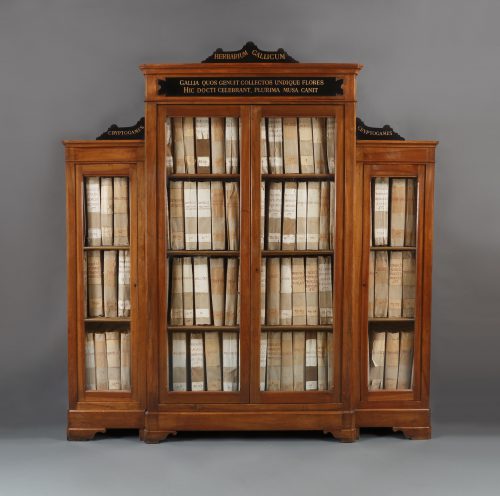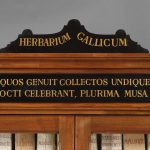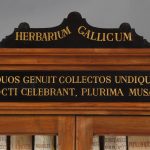11403 HERBARIUM GALLICUMA A VERY RARE FOUR DOOR WALNUT AND EBONIZED BREAKFRONT CABINET DESIGNED TO CONTAIN A COLLECTION OF BOTANICAL SPECIMENS COLLECTED BY M. TH. BERNARD French. Second Half Of The 19th Century. Measurements: Height: 8′ 4 7/8″ (256 cm) Width: 7′ 8 1/2″ (235 cm) Depth: 18 1/2″ (47 cm)

Research
Of walnut, ebonized and gilt decoration. The central section with two full length glazed doors concealing four shelves, flanked on each side with two lower sections with three shelves each contained behind a single glazed door. Ebonized and gilt plaques surmounting the central section inscribed Herbarium Gallicium and Gallia quos genuit collectos undique flores / hic docti celebrant, plurima musa canit; conforming plaques above each side section inscribed cryptogames. The whole raised on six shaped bracket feet. The cabinet holding labeled dossiers containing botanical specimens.
Marks:
Ebonzed and gilded signs inscribed:
Herbarium Gallicum
Gallia quos genuit collectos undique flores / hic docti celebrant, plurima musa canit
Cryptogames
Provenance:
French private collection
This impressive cabinet was specially constructed to house a 19th century herbarium, a collection of preserved plant specimens and associated documentation that functions as a physical botanical encyclopedia. The specimens were traditionally dried, glued or sewn onto sheets of paper, and then placed in boxes or bound in volumes with others of a particular type, a method that remains largely unchanged today.
The practice of observing and preserving plants reaches back to antiquity; the oldest example of this is a bundle of dried olive twigs bound by a palm leaf, dating from circa 305 B.C, found in an Egyptian tomb and conserved in the Royal Botanic Gardens, Kew. Botanical subjects were also described and illustrated in manuscripts called “herbals,” used by apothecaries and physicians. The drying of plants and flowers as keepsakes or devotional objects continued for centuries, but it was not until the Renaissance that they were systematically procured and catalogued to form a botanical database.
The earliest recorded modern-day herbarium was compiled by the Italian physician and botanist Luca Ghini (1500-1556). He served as the founding director of the botanical garden at Pisa at the invitation of Cosimo I de’Medici, Grand Duke of Tuscany (1519-74) in 1543. The earliest extant herbarium dates from the 16th century and was compiled by one of his students, Gherardo Cibo (1512-1600), begun in 1532. A Flemish botanist named Adriaan van den Spigel (1578-1625) “was probably the first scholar to describe how to make a herbarium, complete with a recipe for a suitable glue,”1 published in his book Isagoge in rem herbarium libri duo (“Introduction to matters relating to the herbarium in two books”) in 1606 and 1608.
At this date the collections were referred to as hortus siccus (dry garden) or hortus hiemalis (winter garden), as van den Spigel writes: “since it is not always possible to observe plants in their place of birth—in spring, summer and fall due to bad weather, and in winter because most plants perish then—you should inspect winter gardens (as I call books in which plants glued to sheets of paper are preserved).”2
Increased travel both domestically and as a result of the expansion of European empires to foreign locales in the 16th and 17th centuries provided naturalists with access to new and exotic specimens; personal collections could have several thousand samples ranging from rare mosses to common grasses. The herbarium’s value as a reference with which one could identify, classify or compare plant species was so well established by the mid-18th century that the botanist Carl Linnaeus proclaimed it “necessary to every naturalist.”3
The present herbarium was owned and curated by a collector by the name of Th. Bernard. The ebonized and gilded sign surmounting the cabinet indicates in Latin that it is an Herbarium Gallicum (Herbarium of the French) and below that it reads: Gallia quos genuit collectos undique flores hic docti celebrant, plurima musa canit (“The flowers which France has born collected from all quarters / Here the wise celebrate them, the muses sing”). Devoted entirely to the flora of France, the collection was assembled from towns, large and small, throughout the country, such as Corrèze, Vaucluse, Pornic and Reims.
The painted labels above the sides indicate that this collection was an herbarium cryptogamique. Cryptogames are plants that reproduce by means of spores, without seeds or flowers. The most well known plants in this group are algae, lichen, moss, and fern. Cryptogames form just one of several types of specially assembled collections; other examples include phanerogams (plants that reproduce with seeds), seed banks, fungarium containing fungi or xylarmium, comprising specimens of wood. The folios within the cabinet contain more than just cryptogames, and also include grasses, herbs, succulents, mushrooms, cruciferous plants, legumes, and flowers.
The armoire holds numbered volumes, containing over 1,000 specimens in total. A paper label with Bernard’s name is affixed to each sheet along with the handwritten scientific name of the plant, the location it was taken from, and the date it was entered; the dates range from the1860s through the 1890s. The reverse sides of the sheets contain an elaborated description of the specimens. It is possible that Mr. Bernard donated portions of his original collection to scientific and academic institutions. For example, the Bulletin of the Society of Friends of the Natural Sciences of Rouen, Volume 19 (1883) contains an entry in which a Mr. Bernard is thanked for his gift of cryptogams to the Society: From Mr. Bernard, a magnificent collection of algae of the Seine-Inférieure, containing about one hundred and eighty-four species, which he offers for our cryptogamic herbarium. The President congratulates Mr. Bernard on his research and, on behalf of the Society, extends to him his most sincere thanks for his generous gift.4 For naturalists, the creation of herbaria “was a means to knowledge and not an end to itself.”5 Unlike the curiosity cabinets of old, scholarship was placed above ownership, as evidenced by the ability to share or exchange individual sheets or whole volumes of specimens with other botanists.
Along with the specimen sheets, the armoire contains alphabetized catalogues, botanical ephemera, and correspondence with scientific institutions and antiquarians.
Footnotes:
- Allaby, Michael. Plants: Food, Medicine, and the Green Earth. New York: Facts on File, 2010. 59
- Ogilvie, Brian W. The Science of Describing: Natural History in Renaissance Europe. Chicago: University of Chicago Press, 2006. 172.
- Ibid 169
- Bulletin De La Société Des Amis Des Sciences Naturelles Et Du Muséum De Rouen. Volume 19. Rouen: Société des amis des sciences naturelles et du Muséum de Rouen, 1883. 13.
- Ogilvie, 43.




Comments are closed.